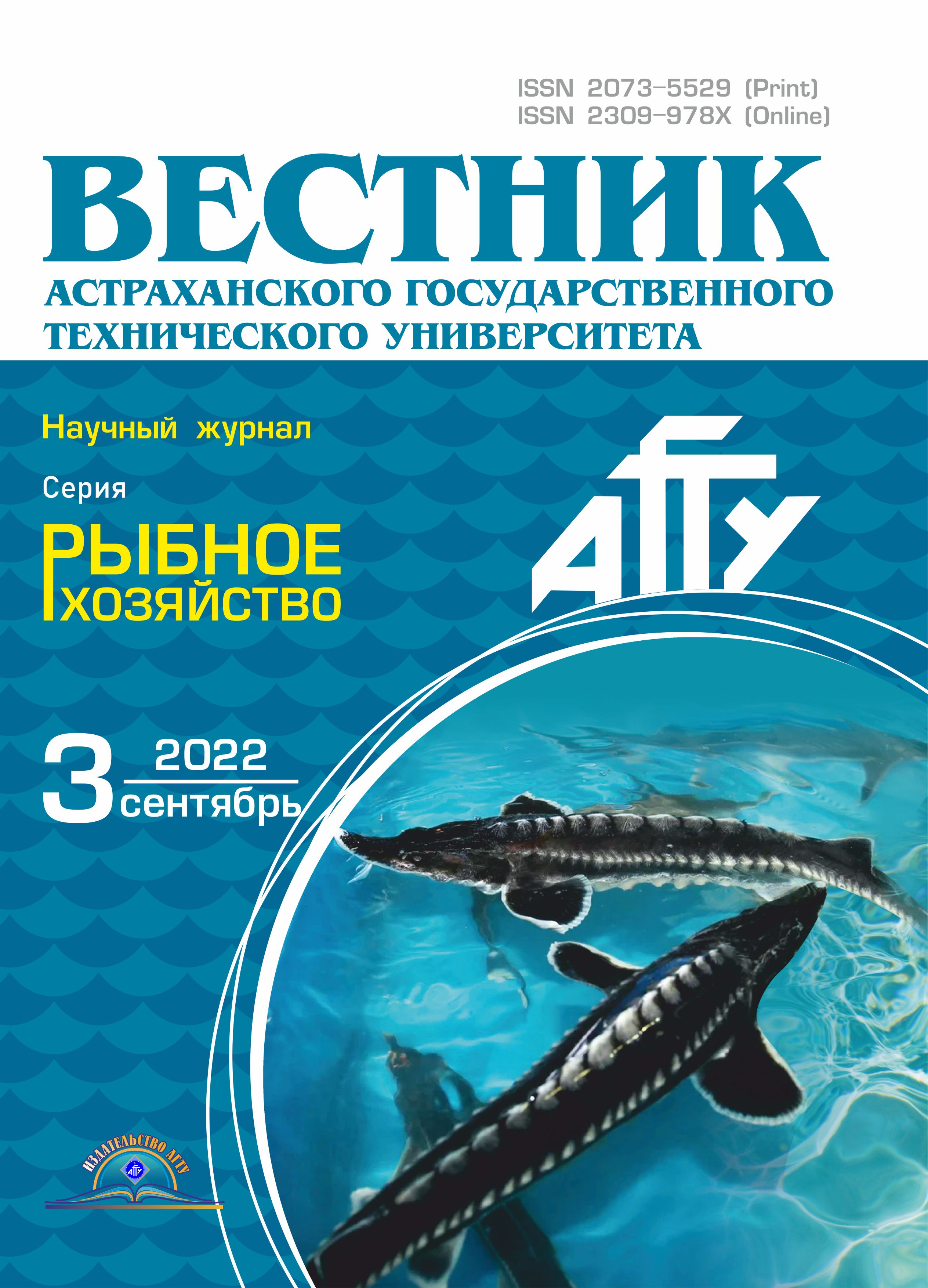Россия
Россия
Выполнен анализ современного состояния рыболовства в Волго-Каспийском подрайоне. Дана оценка процессам деформации водных биологических ресурсов Каспийского бассейна. Современные уловы промысловых рыб снизились на порядок по сравнению с прошлым столетием. В начале ХХ столетия запасы полупроходных и речных видов рыб были значительными, уловы достигали 200–300 тыс. т. В последние годы вылов таких рыб стабилизировался на уровне 36,0–43,3 тыс. т. Уловы воблы, сазана и судака в течение последних лет были самыми низкими за всю историю каспийского рыболовства. Вылов сазана, по сравнению с выловом в 1980-е гг., снизился более чем в 5 раз, воблы – в 6 раз, судака – в 4 раза. С 2003 г. наблюдается снижение вылова леща до 7–10 тыс. т. Резкое снижение уловов обусловлено, прежде всего, коллапсом запасов килек. Остро стоит вопрос о лимитировании и даже полном запрете промысла воблы. По результатам корреляционного анализа (сравнение значений природных факторов с величиной уловов в исследуемых подрайонах) установлено, что добыча рыбы в Волго-Каспийском подрайоне не обнаруживает связей ни с одним из перечисленных природных факторов. Проведен анализ видового состава полупроходных и речных рыб, выловленных различными орудиями лова на Нижней Волге. Видовой состав уловов «секретами» более разнообразен, чем закидными неводами и жаберными сетями. Основу уловов составляют лещ, вобла, щука, сом, красноперка. Спрогнозировано дальнейшее сокращение рыбного промысла в Каспийском бассейне, в том числе в Астраханской области.
Волго-Каспийский бассейн, рыболовство, вылов, состав уловов, орудия лова, промыс- ловый запас
1. Засельский В. И. Развитие морских биологических исследований на Дальнем Востоке в 1923-1941 гг. Владивосток: Изд-во ДВНЦ АН СССР, 1984. 248 с.
2. Объем вылова рыбы и водных биоресурсов в 2021 году превысил 5 миллионов тонн. URL: https://www.moshol14.ru/press-centr/novosti-rynka/ryba-2021 (дата обращения: 27.04.2022).
3. Объявление о запрете промышленного рыболовства плотвы в реке Волга и ее водотоках в Икрянинском, Камызякском, Володарском, Лиманском, Красноярском, Наримановском и Приволжском районах Астраханской области. URL: https://vktu.ru/obyavlenie-o-zaprete-promysh-lennogo-rybolovstva-plotvy-v-reke-volga-i-ee-vodotokah-v-ikryaninskom-kamyzyakskom-volodarskom-limanskom-kras-noyarskom-narimanovskom-i-privolzhskom-rajonah-astrahan-skoj-obl/ (дата обращения: 29.03.2022).
4. Страсти по вобле. URL: https://astrahan.bezformata.com/listnews/holodniy-mart-2022-go/103563600/ (датаобращения: 05.04.2022).
5. Рыбный «краешек»: нашлось ли место региону в госстратегии развития рыбохозяйственного комплекса? URL: https://zen.yandex.ru/media/astrakhansmart/rybnyi-kraeshek-nashlos-li-mesto-regionu-v-gosstrategii-razvitiia-ryboho-ziaisvennogo-kompleksa-5de77dcc32335400b02157f2/ (дата обращения: 27.04.2022).
6. Проблемы и перспективы рыбной отрасли. URL: https://ast-news.ru/node/problemy-i-perspektivy-rybnoy-ot-rasli (дата обращения: 27.04.2022).
7. Гидрометеорология и гидрохимия морей СССР. СПб.: Гидрометеоиздат, 1992. Т. VI. Каспийское море. Вып. 1. Гидрометеорологические условия. 359 с.
8. Карпюк М. И. Современное состояние и факторы, определяющие биологическое разнообразие Волго-Каспийского региона России: автореф. дис. … д-ра биол. наук. Махачкала, 2003. 52 с.
9. Иванов В. П., Комарова Г. В. Рыбы Каспийского моря. Астрахань: Изд-во АГТУ, 2008. 224 с.
10. Васильева Т. В., Шипулин С. В., Канатьев С. В., Ткач В. Н., Лепилина И. Н., Калмыков В. А., Власенко А. Д., Булгакова Т. И. Современное состояние сырьевой базы и ее использование промыслом в Южном рыбохозяйст-венном районе Волжско-Каспийского рыбохозяйствен-ного бассейна // Тр. ВНИРО. 2016. Т. 160. С. 26-40.
11. Иванов В. П., Мажник А. Ю. Рыбное хозяйство Каспийского бассейна (Белая книга). М.: ТОО «Журнал "Рыбное хозяйство"», 1997. 40 с.
12. Васильев С. Н., Имердыков А. Н. Становление рыболовства как отрасли народного хозяйства в Калмыкии // Вестн. ин-та комплексных исследований аридных территорий. 2007. № 2. С. 139-143.
13. Орлов Л. А., Сокольский А. Ф., Глебыч А. И. Каспийское море. О влиянии экологических изменений на биоразнообразие и биопродуктивность. Астрахань: Полиграфком, 2009. 401 с.
14. Власенко А. Д., Власенко С. А. Современное состояние и основные проблемы восстановления рыбных ресурсов Волго-Каспийского бассейна // Вопр. рыболовства. 2012. Т. 13. № 4. С. 719-735.
15. Статистические сведения по рыбной промышленности России. М.: Изд-во ВНИРО, 2021. 90 с.
16. Статистика добычи (вылова) водных биологических ресурсов. URL: https://fish.gov.ru/otraslevaya-deyatelnost/ekonomika-otrasli/statistika-i-analitika/ (дата обращения: 27.04.2022).
17. Волжско-Каспийский рыбохозяйственный бас-сейн. URL: https://fish.gov.ru/obiedinennaya-press-sluzhba/infografika/obshhij-obem-dobychi-vylova-vodnyh-bioresursov(дата обращения: 27.04.2022).
18. Иванов В. П., Зыков Л. А. Динамика уловов и за-пасов Каспийского моря // Юг России: экология, разви-тие. 2009. № 3. С. 50-53.
19. Ходоревская Р. П., Калмыков В. А., Ткач В. Н. Значение комплексных исследований для практических рекомендаций по водным биологическим ресурсам Волжско-Каспийского рыбохозяйственного бассейна // Тр. ВНИРО. 2015. Т. 156. С. 160-176.
20. Балыкин П. А., Ходоревская Р. П. Состояние ры-боловства в Южном районе Волго-Каспийского рыбохозяйственного бассейна // Вестн. Астрахан. гос. техн. ун-та. Сер.: Рыбное хозяйство. 2021. № 3. С. 7-16.
21. Водный баланс и колебания уровня Каспийского моря. Моделирование и прогноз. М.: Триада ЛТД, 2016. 378 с.
22. Государственный доклад об экологической ситуации в Астраханской области. URL: https://nat.astrobl.ru/docs/document-16g5-4e75-35-96g (дата обращения: 05.04.2022).
23. Балыкин П. А., Зыков Л. А., Маркин А. В., Поно-марева Е. Н. Весенний промысел и биологический состав уловов воблы и леща Волго-Каспийского района // Рыбное хозяйство. 2013. № 1. С. 70-74.
24. Барабанов В. В., Ткач В. Н., Шипулин С. В. Опыт оценки неучтенного изъятия полупроходных и речных видов рыб в Астраханской области // Вестн. Астрахан. гос. техн. ун-та. Сер.: Рыбное хозяйство. 2017. № 2. С. 18-25.
25. Матишов Г. Г., Балыкин П. А., Гераскин П. П., Григорьев В. А. и др. Результаты ихтиологических ис-следований на Нижней Волге. Ростов н/Д.: Изд-во ЮНЦ РАН, 2015. 72 с.
26. Фомичев О. А., Сидорова М. А., Ветлугина Т. А., Кузнецов Ю. А. и др. Состояние запасов воблы, леща, судака в 2005 г. и перспективы промыслового использования // Рыбохозяйственные исследования на Каспии. Результаты НИР за 2005 г. Астрахань: Изд-во КаспНИРХ, 2006. С. 220-227.
27. Барабанов В. В., Колосюк Г. Г. К вопросу о целесообразности изменения промысловых мер на промышленный вылов воблы и сома в Волго-Каспийском бассейне (Астраханская область) // Вестн. Астрахан. гос. техн. ун-та. Сер.: Рыбное хозяйство. 2018. № 1. С. 7-13.
















